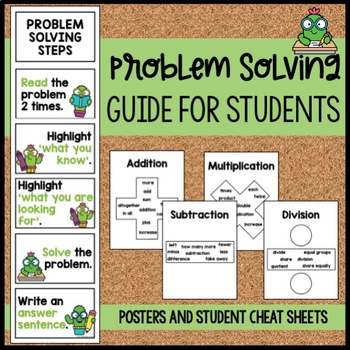Math Problem Solving Poster Steps & Guide | Operations Clue Words | Checklist
- PDF
Description
These problem solving tools are a MUST for guiding children to solve math problems methodically. Display the 5-step problem solving process, model how to solve, hand out bookmarks and review math clue words! All of these math tools help guide students to solve problems independently.
Cactus themed problem-solving aids for students + math tools.
Included:
Problem solving steps - available in 3 formats
1. Two one-page poster formats of the 5 steps to solve a problem.
2. Problem solving guide big poster (over 4 pages).
3. Bookmarks on reminders
Math clue words – available in 2 formats
1. Student cheat sheet (list of all the clue words on half a page) Can also be used as a large bookmark.
2. Operation signs (addition, subtraction, multiplication and division) with clue words written inside.
** All formats include colour and black and white versions.
Students that follow steps to solve problems, are more likely to understand the problem more in depth and produce a more complete answer. After teaching the 5 steps to solve a problem (and repeating them many times), I post the large ‘steps for problem solving’ on the class wall. When solving a problem together, I model how to go through the steps. Usually, they have 2 highlighter colours for each step.
I provide them with the bookmark to save their spot in their problem-solving books.
Also posted on the wall are the 4 operation signs with the math clue words. This serves as a reminder of what operation to use based on the vocabulary in the problem. Student cheat sheets are also available.
These tools are also great resources to add to IEP's. Checklists and visuals are a must for IEP students as well as the whole class! Check out my blog to find out more Savvy Elementary Teacher Blog.
From your Canadian resource teacher, living in Quebec.
Thank you so much for supporting my small business. If you enjoyed this product, please leave a much-appreciated rating to earn TPT credits and click on the star to follow me to be the first to receive updates on freebies and more ⭐⭐⭐⭐⭐
Tag me @savvyelementaryteacher ⭐I would love to see my products in action! Check out my blog to get more teaching ideas Savvy Elementary Teacher Blog.





